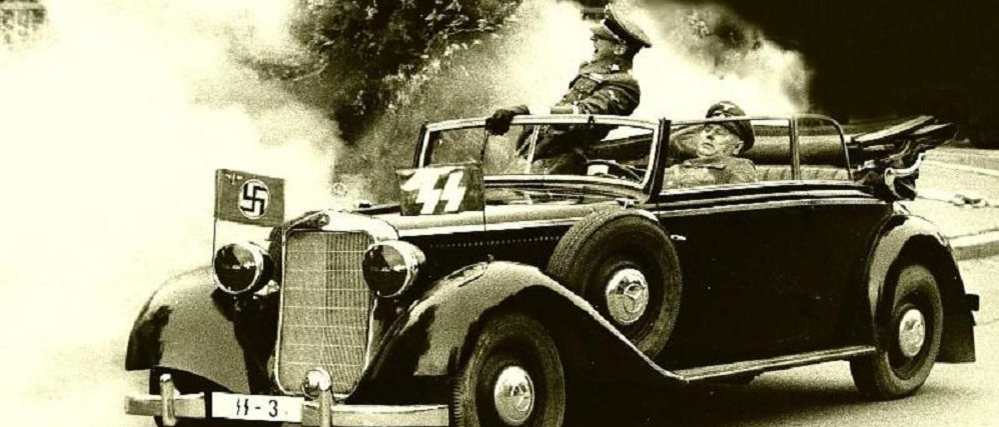The Assassination of Heydrich
Posted on 25th February 2021
If there was one man in the Third Reich more feared than Heinrich Himmler it was his handsome and distant deputy Reinhard Heydrich, a man whose power increased at such a pace that for a short time it was even thought he was being groomed as the Fuhrer’s successor.
Considered the architect of the Final Solution he was as ruthless in pursuit of his own ambitions and was as determined to eradicate those he thought undesirables and enemies of the State.
Reinhard Tristan Eugen Heydrich was born in the town of Halle in Saxony-Anhalt, on 7 March 1904. His father, Richard, was a composer, music teacher and an ardent nationalist who regaled his children with stories of German heroes and of the countries unique place in the world. His mother, Elisabeth was the perfect hausfrau subservient to her husband in all things and dedicated to the raising of her children. Family life was strict and discipline harsh with the children regularly subjected to physical correction, but Reinhard was for the most part a good boy becoming an accomplished violinist and sportsmen. Even so, he was frequently bullied at school for his Roman Catholicism and high-pitched voice.
Raised as a patriot he was excited by the Great War but too young to serve made up for lost time by joining the paramilitary Freikorps that was responsible for suppressing the Communist led Spartakist revolt in Berlin and elsewhere.

In 1922 he joined the German Navy where he rose to the rank of Lieutenant, but it was hardly a meteoric rise and he was intensely disliked by his fellow Officers whom he dismissed as his social inferiors refusing to attend their social events and even to dine with them. His flagrant womanising was also frowned upon and his career in the Navy was curtailed in 1931 when he was dismissed for inappropriate behaviour. He had refused to do the decent thing and marry a woman he had impregnated claiming that she was of loose morals and had been too easily seduced. She was also his social inferior, and it would be an insult to his family to take her as a bride. He would his mind once it became clear his behaviour might jeopardise his career but by then it was too late; devastated by his dismissal and loss of rank in 1932 he volunteered for the recently formed Schutzstaffel or SS, where he quickly rose to the rank of Major; not long after he was interviewed by Heinrich Himmler for a post in the Counterintelligence Division. Himmler was apparently impressed by this man he found to be as bloodless as he was.
Heydrich had found his place and was to play a prominent role in the purge of Ernst Rohm and the S.A, known as the Night of the Long Knives and the anti-Jewish pogrom of Kristallnacht, and over the next few years he was to build the Gestapo into a powerful weapon of control advocating the arrest of people on mere suspicion alone while encouraging denunciation as a means of intimidation.
On 17 June 1936, all German State Police and Intelligence Services were brought under Himmler’s control and he appointed Heydrich as his Deputy; but it was also around this time that Heydrich’s rise to prominence was almost brought to a jarring halt.
Rumours he had a Jewish ancestry had long been circulating and they were being used by his enemies of which he had a great many to undermine his position and they were soon brought to the attention of Himmler who ordered an investigation into his genealogy. The findings of the investigation were unclear, and Himmler felt obliged to put the matter before Hitler who personally interrogated Heydrich.
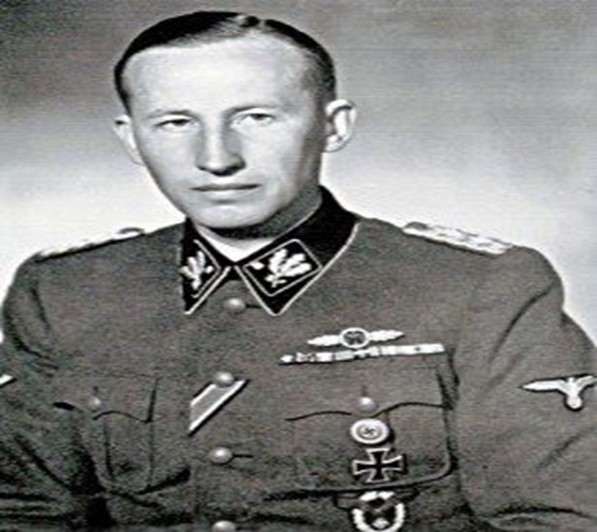
Hitler was suitably impressed by the gaunt Heydrich with the steely look in his eye and concluded that he was enthused with National Socialist ardour. Any suspicion of tainted blood could only be used to ensure blind obedience in the future. Heydrich who had been shaken by the turn of events tried hard not show it and was soon back at his desk where he remained resolute in his commitment to the Nazi cause in the manner of the remorseless bureaucrat he undoubtedly was.
In 1941, he was instrumental in implementing the Nacht und Nebel, or Night and Fog Decree, designed to crush resistance in German Occupied Europe. Suspects would be picked up in the dead of night and simply disappear, there was no formal arrest and no charges brought. On 27 September 1941 he was appointed Reich Protector of Bohemia and Moravia where his cruelty soon earned him the title “The Hangman of Prague” but he was never going to be satisfied with merely being the Governor of a province of the Greater Germany.
On 20 January 1942 he convened a conference in the Berlin suburb of Wannsee to find the Final Solution to the Jewish Question. Attending were representatives of all the leading Ministries of the Third Reich. Heydrich told them in no uncertain terms that all Jews who could do physical labour would be made to do so, if they died in the process then so much the better; that incapable of work, or were of no use to the Reich, would be physically eliminated.
That Jews were already being murdered in their tens of thousands by Nazi Einsatzgruppen Death Squads was already well known and the reason for the conference was not so much the implementation of policy but to formalise and speed up the process for the extermination of the Jewish Race in Europe, and no one was to be left in any doubt as to who was in charge of this process – Heydrich would direct it and he would benefit from its success.
The Conference at Wannsee allowed little discussion and permitted no dissent and so in a meeting that lasted barely 90 minutes with a break for lunch a commitment was made to mass-murder. This was Heydrich’s modus operandi, to work fast, bully, intimidate and get things done, and he was untroubled by conscience. One of his subordinates, Walter Schellenberg, later said of him: “He had a cruel, cold intelligence and was a man for whom truth and intrinsic goodness had no meaning”.
In Britain, the Prime Minister Winston Churchill had established the Special Operations Executive (S.O.E). At a time when the countries very, survival was in the balance any significant British military intervention on the Continent was unthinkable. Churchill however was determined to maintain a British presence and strike back where possible, and so the S.O.E was formed. British agents would be parachuted into Nazi Occupied Europe to liaise with local resistance groups and to carry out acts of sabotage and assassination. One of those targeted was, Reinhard Heydrich.
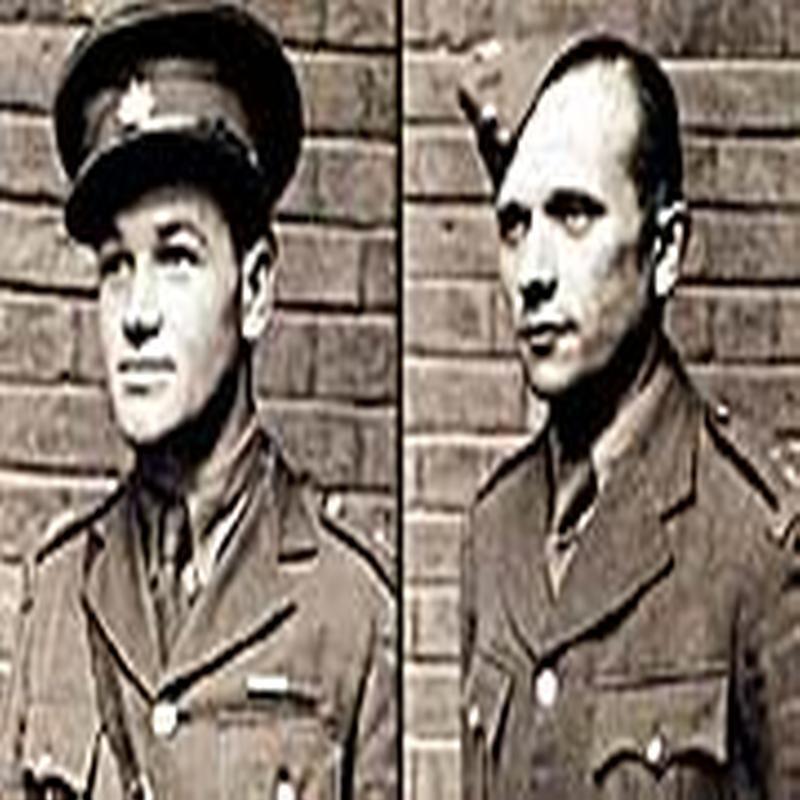
Two soldiers from the Czech Army in Exile, Karel Svoboda and Jozef Gabcik were chosen to carry out the operation to assassinate Heydrich. When Svoboda was injured in training Jan Kubis was chosen to replace him. This sudden change of personnel delayed the implementation of Operation Anthropoid for some months, and it wasn’t until 28 December 1941 that Gabcik and Kubis landed near the town of Nevizdy from where they travelled onto Prague staying with families connected to the resistance and making contact with local anti-Nazi organisations.
For months Gabcik and Kubis remained in hiding while they made their plans. Throughout their time in Prague the Nazi Authorities remained unaware of their presence and they were able to roam the streets of the city and reconnoitre the area relatively unmolested. Various plans were shelved and attempts to assassinate Heydrich aborted at the last moment before finally they decided to intercept the Reich Protector on his daily commute from his home to his official residency at Prague Castle.
On 27 May 1942, the always meticulous Heydrich journeyed in his open-top Mercedes at his usual time and without protection. He did so in a show of contempt for the Czech people. As the car slowed significantly to round a curve in the road near the Bulovka Hospital, Gabcik, who along with Kubis had been waiting at a nearby tram stop, stepped out in front of the car and aimed his machine gun straight at Heydrich but it jammed. Instead of speeding off, Heydrich ordered his driver Klein to stop the car and made to shoot Gabcik. As he did so Kubis emerged from the shadows and threw a grenade. It missed its intended target hitting the rear end of the car before exploding. Gabcik and Kubis, believing their assassination attempt had failed now fled with Heydrich anf Klein in hot pursuit.
It appeared at first that Heydrich had escaped relatively unharmed but he had in fact been wounded by shrapnel and soon collapsed. Despite his own incapacity he ordered Klein to continue the pursuit. He was later intercepted by Gabcik who shot him dead.
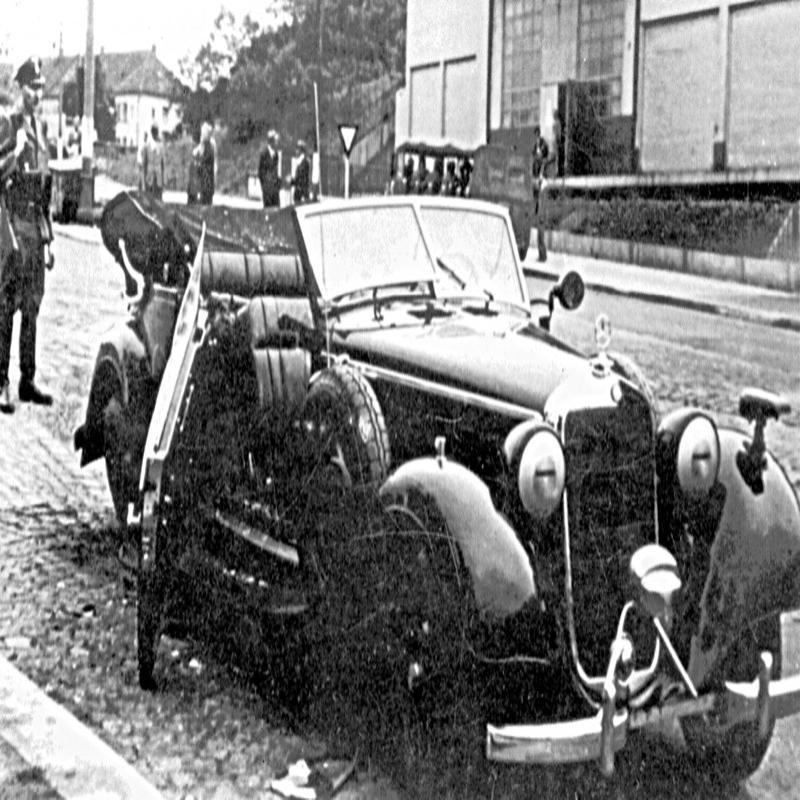
Heydrich was rushed to hospital where the diagnosis was a positive one. His wounds the doctors told him were neither serious nor life-threatening and that he should make a full recovery. In the meantime, a massive man-hunt was launched to find his would-be assassins.
On 3 June, whilst sitting up in bed eating his noon day meal, Heydrich collapsed and went into a coma. By the following morning he was dead, it was said of blood poisoning.
Gabcik and Kubis, who believed they had failed in their mission were as shocked as anyone else to hear the news.
At Heydrich’s funeral procession in Prague on 7 June the city’s inhabitants were forced onto the streets to pay their respects. Following this his body was transported to Berlin where a second more elaborate funeral took place at which Hitler read the eulogy.
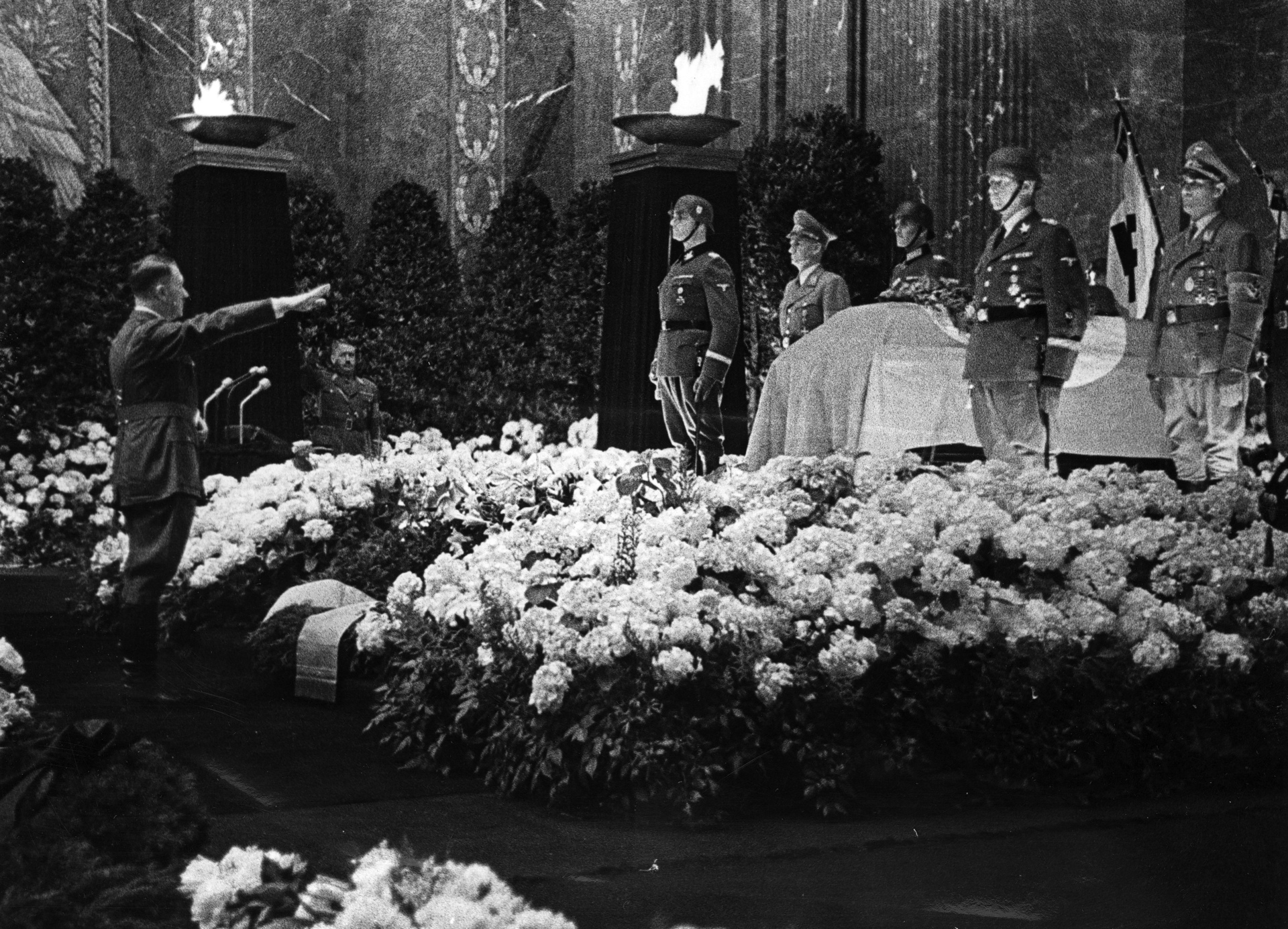
Praising him as a martyr he was to remark in private that he thought Heydrich’s behaviour in travelling around Prague unescorted and unprotected to be idiotic and stupid. Nonetheless, he was furious and ordered the SS to wade in blood, if necessary, in their efforts to find the killers and over the next fortnight more than 13,000 Prague citizens were arrested. Many were shot or hanged while others were sent to Concentration Camps.
The most notorious incident occurred in the village of Lidice where the SS rounded up and shot dead its 199 male inhabitants, took away 95 children many of whom were later sent to Germany for adoption, and sent the 195 women to Concentration Camps. The village was then raised to the ground. Yet for all their brutality the SS and the Gestapo were unable to track down the assassins, but the noose was tightening.
Gabcik and Kubis, who had been hiding in different homes in Prague, now departed for the sake of the families involved and along with five other resistance fighters who were on the run sought refuge in the Church of St Cyril and Methodius.

Unknown to them however, Karel Curda, a member of the Out Distance Resistance Group that had been parachuted into Czechoslovakia to carry out sabotage missions had been arrested and under the threat of torture and for a reward of 1 million Reichsmarks he agreed to tell all he knew and reveal the names of all the contacts and the addresses of the safe houses. It was with the information provided by Curda that the Gestapo were able to close in on their prey.
One of the safe houses where Gabcik and Kubis had stayed was that of the Moraver family. When the house was raided Mrs Moraver committed suicide by taking a cyanide tablet. Her husband, who had been unaware of his wife’s involvement in the resistance and their young son, Ata, were taken to the Gestapo Headquarters at Pecek Palace.
The Gestapo focused their attention on the 14-year-old boy but much to their surprise he revealed nothing under torture but then stupefied with brandy and shown the severed head of his mother floating in a fish tank he cracked. The following day 18 June the Church of Saint Cyril and Methodius was surrounded by 700 SS troops. Aware of the fate that awaited them should they do so the seven men inside refused to surrender and a furious two-hour gun battle ensued.
Jan Kubis and two others took up position in the Prayer Loft whilst the four remaining men sought refuge in the Church Crypt.
Kubis and his comrades fought for their lives but were soon overwhelmed. The Germans however could not gain entry into the crypt and so in their frustration decided to flood it with water using the ventilation shafts. Unable to stem the flow of the water Gabcik and the others fought on until their ammunition was almost expended and they were close to drowning. Still unwilling to surrender they shot themselves. In the fighting 14 SS troops had been killed and 21 wounded.
Reinhard Heydrich was to be the only leading member of the Nazi Regime to be assassinated during the war.
The implementation by the Germans of a policy of collective responsibility and the levels of reprisal they were willing to undertake on the civilian population forced Churchill into abandoning any further attempts on the lives of the leading Nazis.
Following the liberation of the Czech lands in 1945, Karel Curda made no attempt to flee but continued to live openly and well on the reward he had received for betraying his colleagues. But the good life didn’t last long, and he was soon arrested, tried to for treason and hanged at Pankrac Prison on 27 April 1947.
Share this post:





